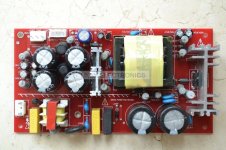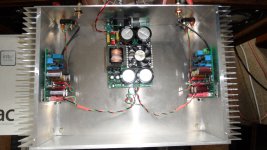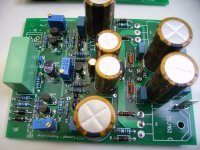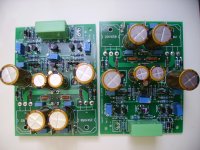Great thanks..
Not wanting to add any complexity and clearly have No experiences on what I want Or works 'better'.
Only that leds were used in my past, wasn't aware that they weren't the only path.
More 'Trust' is implied then ? 🙂
http://waltjung.org/PDFs/Sources_101_P1.pdf
The LED CCS has higher effective impedance than the two transistor CCS. A reference diode is even higher, but they are noisier. Either one is simple to use with this circuit.
Sheldon
Matching?
Given that Jason supplied a generous assortment of Transistors.
I 'should' match them.
Don't have a DVM with an transistor test/hfe plug. Could get one those things, they are ~$5 🙄
But it's a 2+ hour round trip drive to Princess Auto
Found this instruction though:
Apologies if this has been suggested before, but I haven’t seen this idea in print.
When Vbe matching transistors, we are looking to measure about 600 mV to 1 mV or better accuracy, with a constant current source. This is exactly what the diode test facility on a cheap multimeter is designed to do. Hence, if you take an NPN transistor, connect the base to the collector, switch your DVM to diode test and connect the positive lead to collector and negative to emitter, the display will show Vbe in mV. The usual temperature and stability rules apply. For PNP transistors, just swap the leads over.
Considerations:
1. The test current is usually 1 mA, an order of magnitude greater than most circuits presented, but not, it seems, enough to cause measurement problems (at least not when I tried it).
2. Most DVMs will only measure to +/- 1 mV, only just about sufficient.
On the plus side:
1. It’s cheap and simple.
2. It is a genuine constant-current measurement.
3. You’re probably using that DVM to measure the Vbe anyway.
4. It’s slightly better than Yves’ simple rig, and you save on the power supply and resistor!
5. I’ve tried it and it appears to work pretty well.
Sooo? will this work as opposed to hfe matching through a cheapo DVM transistor check plug.
Ummm... Which transistors need matching 😱 ?
Given that Jason supplied a generous assortment of Transistors.
I 'should' match them.
Don't have a DVM with an transistor test/hfe plug. Could get one those things, they are ~$5 🙄
But it's a 2+ hour round trip drive to Princess Auto
Found this instruction though:
Apologies if this has been suggested before, but I haven’t seen this idea in print.
When Vbe matching transistors, we are looking to measure about 600 mV to 1 mV or better accuracy, with a constant current source. This is exactly what the diode test facility on a cheap multimeter is designed to do. Hence, if you take an NPN transistor, connect the base to the collector, switch your DVM to diode test and connect the positive lead to collector and negative to emitter, the display will show Vbe in mV. The usual temperature and stability rules apply. For PNP transistors, just swap the leads over.
Considerations:
1. The test current is usually 1 mA, an order of magnitude greater than most circuits presented, but not, it seems, enough to cause measurement problems (at least not when I tried it).
2. Most DVMs will only measure to +/- 1 mV, only just about sufficient.
On the plus side:
1. It’s cheap and simple.
2. It is a genuine constant-current measurement.
3. You’re probably using that DVM to measure the Vbe anyway.
4. It’s slightly better than Yves’ simple rig, and you save on the power supply and resistor!
5. I’ve tried it and it appears to work pretty well.
Sooo? will this work as opposed to hfe matching through a cheapo DVM transistor check plug.
Ummm... Which transistors need matching 😱 ?
Last edited:
The test you show is testing the voltage drop of a 'diode connected' transistor. I personally would be more concerned about the gain (hFE) of the devices being within 20% of one another for complimentary devices.
I just want to re-iterate: the design does not require matching. I sent you more than you needed so if you chose to do so you could get a 'best fit'. The quantity I sent could just as easily not be large enough to get a match either. I'm sure the VAS devices, the TO-126 ones, won't give an exact match. They are from leftovers I had from actual matching with a curve tracer. The matched devices have been used so I pulled from the closest gain 'bins' I had and sent you several of each device. Just use them 'as-is'.
As for which devices to attempt to match, I'd suggest priority goes to the input pair followed by the VAS. Within 20% would be just fine if you are going to bother at all. No matching is required or is even realistic for the outputs.
I just want to re-iterate: the design does not require matching. I sent you more than you needed so if you chose to do so you could get a 'best fit'. The quantity I sent could just as easily not be large enough to get a match either. I'm sure the VAS devices, the TO-126 ones, won't give an exact match. They are from leftovers I had from actual matching with a curve tracer. The matched devices have been used so I pulled from the closest gain 'bins' I had and sent you several of each device. Just use them 'as-is'.
As for which devices to attempt to match, I'd suggest priority goes to the input pair followed by the VAS. Within 20% would be just fine if you are going to bother at all. No matching is required or is even realistic for the outputs.
Thank you..
Apologies if annoying, but I ..am.. new to this.
I will locate a dvm with the plug, in typical ocd behavior.
I suspect though that I will ultimately follow your advise 🙂
Another point that confuses me is the Power Supply.
The connex smps at ~$60 looks promising, ie; affordable🙂
Seemingly a fairly popular choice
Cheap is good, also aware of buy cheap, buy twice possibilities though.
If I read correctly..you had problems with your example ?
However Still4given didn't ?
No way of adapting a Computer PS ?
Are they even suitable.. dunno just curious ?
Some are quite decently made and sold in the millions.
I'm in no need of more than 50 watts, likely less than that, as my speakers are 94db.
But they optimally require an Amp with 'backbone' (current capability) in my experiences.. for convincing bass/dynamics.
What PS voltage would you suggest, 38v or 48v or ?
cheers
Apologies if annoying, but I ..am.. new to this.
I will locate a dvm with the plug, in typical ocd behavior.
I suspect though that I will ultimately follow your advise 🙂
Another point that confuses me is the Power Supply.
The connex smps at ~$60 looks promising, ie; affordable🙂
Seemingly a fairly popular choice
Cheap is good, also aware of buy cheap, buy twice possibilities though.
If I read correctly..you had problems with your example ?
However Still4given didn't ?
No way of adapting a Computer PS ?
Are they even suitable.. dunno just curious ?
Some are quite decently made and sold in the millions.
I'm in no need of more than 50 watts, likely less than that, as my speakers are 94db.
But they optimally require an Amp with 'backbone' (current capability) in my experiences.. for convincing bass/dynamics.
What PS voltage would you suggest, 38v or 48v or ?
cheers
Thank you..
Apologies if annoying, but I ..am.. new to this.
I will locate a dvm with the plug, in typical ocd behavior.
I suspect though that I will ultimately follow your advise 🙂
Another point that confuses me is the Power Supply.
The connex smps at ~$60 looks promising, ie; affordable🙂
Seemingly a fairly popular choice
Cheap is good, also aware of buy cheap, buy twice possibilities though.
If I read correctly..you had problems with your example ?
However Still4given didn't ?
No way of adapting a Computer PS ?
Are they even suitable.. dunno just curious ?
Some are quite decently made and sold in the millions.
I'm in no need of more than 50 watts, likely less than that, as my speakers are 94db.
But they optimally require an Amp with 'backbone' (current capability) in my experiences.. for convincing bass/dynamics.
What PS voltage would you suggest, 38v or 48v or ?
cheers
No annoyance, I'd rather answer a few queries than have to help troubleshoot a problem.
I bought a Connex SMPS500R, and yes I had an issue with it. It remains yet to be resolved, so I'll say my personal experience with that supplier has been less than stellar. Others have bought the Connex SMPS300RE and have apparently had success with those. I also had a bad experience with a ColdAmp SPS30, no recommendation / endorsement from me for that supplier either. Their product was at a premium price with no response regarding my dead unit. My DPS-400LV from AudioPower (forum user AP2) had worked well and despite his 'interesting' personality was easy to deal with and the product was offered at a decent price point.
I wouldn't bother trying to 'hack' a PC SMPS, they are not set up for the voltages we want anyhow.
There is absolutely nothing wrong with an old fashioned linear bulk supply, especially if you CRC filter it.
As for supply voltages, the amplifier works very well in the +/-30V to +/-45V range, with +/-45V being the maximum. Please do not feed it from higher rails as the output devices would be too stressed. People have asked about higher rails and the consistent stern answer is NO. The common most suitable SMPSs are generally available in the specified range and for linear supplies transformers of ~250VA+ in 22-0-22 to 32-0-32 VAC range are suited to the task.
This is probably against popular opinion but I ran this amp on this SMPS for a few hours today. I placed in on my A/B setup next to my TO-3 Peeceebee and there is only the very slightest advantage to the Peeceebee and it is running +-38V rails against this +-25V. I hooked it up to the scope and it looks very clean and begins clipping at 15vac into an 8R load so that is about 28watts. Plays nice into 4ohms. I don't have a 4 ohm dummy load to measure for you. Anyway, for a $30 investment worth looking at.
Blessings. Terry
Blessings. Terry
Attachments
Hi Bare
Do not overlook Hypex SMPS400A180, works like a charm. Producer is very reliable, not even one problem with any of their products.
Regards L.C.
Do not overlook Hypex SMPS400A180, works like a charm. Producer is very reliable, not even one problem with any of their products.

Regards L.C.
Hi Bare
Do not overlook Hypex SMPS400A180, works like a charm. Producer is very reliable, not even one problem with any of their products.
Regards L.C.
Yes, I forgot to mention that one though I don't yet have personal experience with it. Thanks for the reminder LC.
Great information ! thank you all.
Still4given..your 'inexpensive' SMPS IS attractive.. a contender for sure.
I could even consider a dual PS at that price point
Costs are a concern, being a retiree... Real life is what it is.
The Hypex specs certainly read as V Good.. but then it ..is.. 3X the price of the 'cheapy'.
I can certainly buy One. But only if proves as the best possible solution.
Lots to carefully consider ..Before.. ordering. Fortunately, not today's problem.
Did locate a dvm with a hfe plug..buried in my workshop.. serendipitously.
Seems I possess a full set of transistors with hfe measured (3x to be sure) within 3 digits.
IMO, good enough for the Girrrlz I go out with... not to mention my hearing 🙂
Still4given..your 'inexpensive' SMPS IS attractive.. a contender for sure.
I could even consider a dual PS at that price point
Costs are a concern, being a retiree... Real life is what it is.
The Hypex specs certainly read as V Good.. but then it ..is.. 3X the price of the 'cheapy'.
I can certainly buy One. But only if proves as the best possible solution.
Lots to carefully consider ..Before.. ordering. Fortunately, not today's problem.
Did locate a dvm with a hfe plug..buried in my workshop.. serendipitously.
Seems I possess a full set of transistors with hfe measured (3x to be sure) within 3 digits.
IMO, good enough for the Girrrlz I go out with... not to mention my hearing 🙂
Last edited:
I am sure the Hypex is a better unit. I just wanted folks to know that this SMPS will do the job and surprising well considering it is only +-25V. The VSSA doesn't seem to mind at all. As of this moment it has been driving 4 JBL cabinets for 8 hours and not breaking a sweat. For $30 it is a no-brainer and a great little tool to have around the bench. It also has a +-15V output that I have found very useful for matching MOSFETs. I even ran a Symasym V5.2 with it and it sounded fine. I like it a lot better than the Connex I bought.
Blessings, Terry
Blessings, Terry
I believe so. It holds its voltage very well. I'm not saying it will beat the other smps out there. I'm saying it works and it is a nice tool to have around for quick setup and that I was quite surprised how well both my VSSA and Symasym sounded when driven by it. It would be nice if someone else would try one to give a second opinion. I replaced the plugs with screw terminals because I didn't' have matching female plugs. They should probably include those.
Blessings, Terry
Blessings, Terry
Building a Mouser Excel order. Definitely a 'new' adventure 🙂
PS: are those Cheap green screw down connector contraptions, as typically featured in $10 Chinese 'amps' necessary ?
I have unpleasant experiences with those.
OK to simply solder the connecting wire(s)?
Been studying the PCB to double check on bits needed..I see an oddity with R20 and 21
These have 'extra' holes..What? are the inner hole(s) on Both R20 and R21 for.. Short resistors 🙂 Remainders? Or?
Also what is the orientation of KSA and KSC.. referenced to their printed/numbers face ?
PS: are those Cheap green screw down connector contraptions, as typically featured in $10 Chinese 'amps' necessary ?
I have unpleasant experiences with those.
OK to simply solder the connecting wire(s)?
Been studying the PCB to double check on bits needed..I see an oddity with R20 and 21
These have 'extra' holes..What? are the inner hole(s) on Both R20 and R21 for.. Short resistors 🙂 Remainders? Or?
Also what is the orientation of KSA and KSC.. referenced to their printed/numbers face ?
Building a Mouser Excel order. Definitely a 'new' adventure 🙂
PS: are those Cheap green screw down connector contraptions, as typically featured in $10 Chinese 'amps' necessary ?
I have unpleasant experiences with those.
OK to simply solder the connecting wire(s)?
Been studying the PCB to double check on bits needed..I see an oddity with R20 and 21
These have 'extra' holes..What? are the inner hole(s) on Both R20 and R21 for.. Short resistors 🙂 Remainders? Or?
Also what is the orientation of KSA and KSC.. referenced to their printed/numbers face ?
You may solder directly or use pin header type connectors, choice of how to connect is up to the individual constructor's preference.
R20 and R21 do not have 'extra' holes. Those are vias where traces change sides. You can leave them as-is, or put a small spot of solder on them if you choose.
The KSA and KSC are oriented 'face up', with the print visible when attached to the heat sink. The leads are bent up to pass into the holes on the PCB.
Last edited:
Jason,
Here is my latest build with your boards. Still Awaiting a power Switch for the front panel.
It Sounds Great. Has enough punch for my taste in the bottom end & still maintains that clarity all VSSA are known for. 😀
Rick.
Here is my latest build with your boards. Still Awaiting a power Switch for the front panel.
It Sounds Great. Has enough punch for my taste in the bottom end & still maintains that clarity all VSSA are known for. 😀
Rick.
Very glad you have been happy. Nice looking builds, thanks for sharing.
I hope others do a little show and tell too.
I hope others do a little show and tell too.
Hey! Me too 😱
My Jason boards 'populated' awaiting eventual smps delivery, from china.
Lots of time to figure out what to use for heatsinks and boxes.
Angle bent Ali checkerplate as heatsink has an odd attraction.
Wanting discrete dual mono cases both for amps and smps
Or at least that's todays' wish list 🙄.
Oops ...just noticed that there are Sillycone pads under the Big transistors in Rick's build. Isolation req'd ? As in the things' metal plates have voltage?
My Jason boards 'populated' awaiting eventual smps delivery, from china.
Lots of time to figure out what to use for heatsinks and boxes.
Angle bent Ali checkerplate as heatsink has an odd attraction.
Wanting discrete dual mono cases both for amps and smps
Or at least that's todays' wish list 🙄.
Oops ...just noticed that there are Sillycone pads under the Big transistors in Rick's build. Isolation req'd ? As in the things' metal plates have voltage?
Attachments
Last edited:
- Status
- Not open for further replies.
- Home
- Amplifiers
- Solid State
- VSSA Through-Hole Version by Jason




